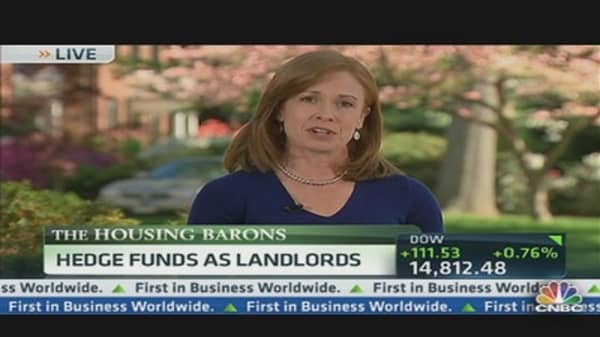Los Angeles-based Colony Capital, which boasts approximately ten thousand single-family rental homes in its portfolio, had centered its investments largely in the Southwest and West, but is now shifting to other markets.
(Read More: US Pending Home Sales Tick Upward in March)
"In terms of our mix, less is going to Arizona and California today," said Justin Chang a principal at Colony. "Our mix is increasing on east coast, Georgia, Florida, we're active in Texas. I think over time some of the early markets will become a smaller part of our overall portfolio."
Some investors are also starting to look at new construction, as home builders start to ramp up production again. The key is to find new product that is cheaper than replacement costs, which still is not that easy. So far investment has mostly gone only as far as distressed new homes, but as prices rise, that may change.
"On home building, there's a lot of chatter about that. We are in some conversations with builders," explained Chang, who admits the economics have not been compelling yet. "Over time you'll see more and more of these transactions, and we may do one as well."
Another potential strategy going forward is a consolidation, as investors turn away from distressed properties and focus on so-called "Mom and Pop" landlords, who may buy just one or two properties. There are an estimated 14 million single family rental homes owned by this cohort.
"If you think about all of the major institutions maybe owning 70,000 total homes compared to the market size of 14 million homes, the long term potential is enormous. Institutions are literally a fly on an elephant," said Aaron Edelheit, CEO of The American Home, an Atlanta-based company that owns and manages about 2,500 homes. "We may look back and realize that the REO [real estate owned] to rental space was only the foundation for an exponentially larger industry with institutions owning hundreds of thousands, if not millions, of homes."
(Read More: Next Boom? 'Spec' Homes Are Back)
There are 7.2 million more renters today than there were in 2004, and just 400,000 more homeowners, according to the U.S. Census.
Despite the recovery in home sales, the homeownership rate continues to fall, from an all-time high of 69.2 percent to 65 percent in the first quarter of 2013. As home prices rise and the employment picture improves, more people will come back to home ownership, and some of the new rental homes will inevitably be sold, but certainly not all of them.
"If you buy homes in areas with below-median income, I think the mortgage market is going to have harder time providing credit to these people, and it's going to take longer for that to recover," said Bloemker. "We think that these homes are more likely to be long term rentals, and those are likely to end up in the hands of institutional investors."
—By CNBC's Diana Olick; Follow her on Twitter @Diana_Olick or on Facebook at facebook.com/DianaOlickCNBC
—CNBC's Stephanie Dhue contributed to this story
Questions? Comments? RealtyCheck@cnbc.com




